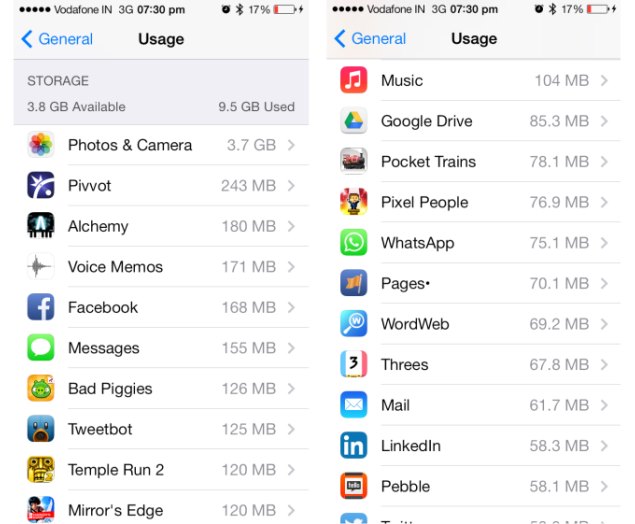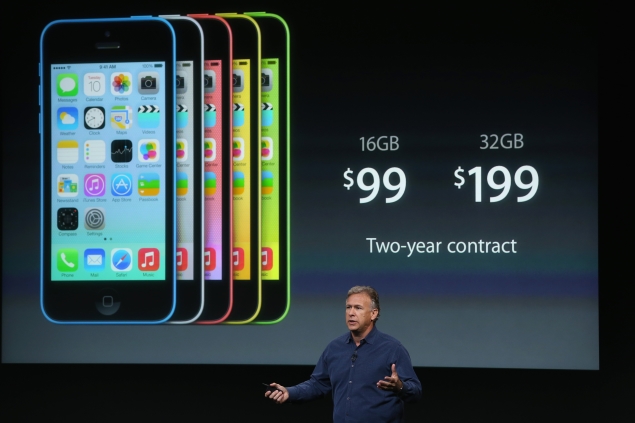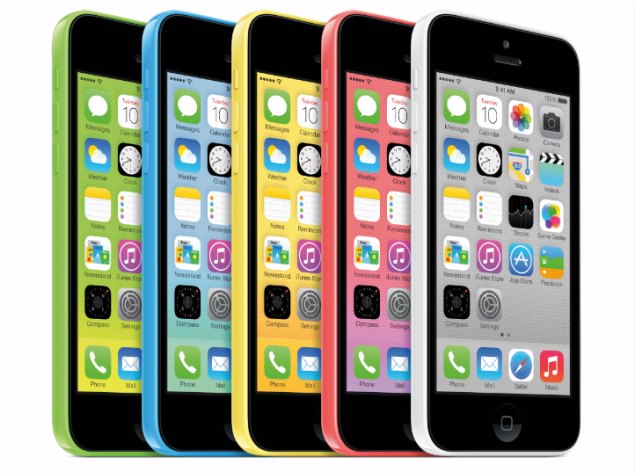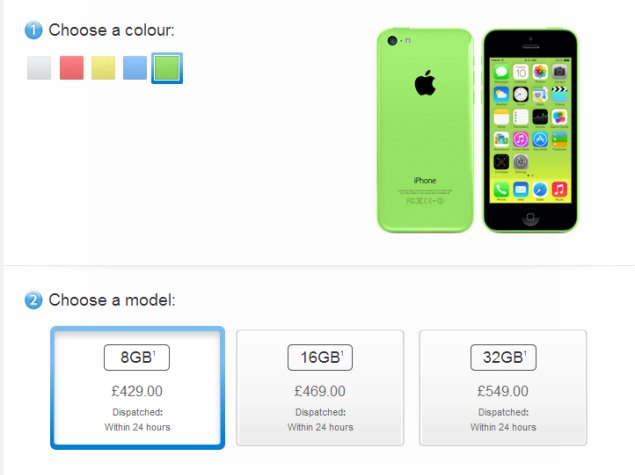The
launch of the cut-price 8GB iPhone 5c is a major disruption for Apple,
and one that clearly signals a weakening of the company's previously
impenetrable attitude with regards to its product strategy. First of
all, it comes in the middle of a product lifecycle, which has never
happened before. Second, it's a crippling reduction of the capabilities
of a product that's already considered undesirable. Third, the discount
itself is half-hearted at best, showing Apple's inability to decide
whether to continue isolating itself in the premium space as it used to,
or embrace the mass market once and for all.
8GB is simply not
enough space for a phone at this price point. Even 16GB is a compromise.
Apple continues to advertise the 5c as a fun product, capable of
functioning as a video camera, music player and game console, amongst
other things. 8GB won't be enough to store more than a small handful of
apps and games, let alone music, photos or videos.
Breaking it down
The
16GB iPhone 5c offers users 13.3GB of actual usable space, while the
32GB version gives users a little over 27GB. That means buyers of the
8GB version will be lucky to get 6GB of usable space. Apple's own iWork
apps; Pages, Numbers and Keynote, weigh in at 253MB, 223MB and 444MB
respectively in the App Store, which is nearly 1GB gone right there.
Garage Band alone is 582MB, and that's without any of the downloadable
sound packs. They occupy far more space when installed.
Apps are
far larger than they used to be, largely thanks to the use of high-resolution
graphics. Taking a look at today's most popular ones, we can see that
Facebook is listed in the App Store at 60MB, but it happily takes up
107MB on an iPhone 5c, with an additional 61MB of "documents and data".
Twitter is listed as 14.7MB, though it needs around 27MB, with an
additional "documents and data" cache which can easily balloon to twice
that amount. Apps that depend heavily on data hosted on remote servers
also aggressively cache data to your phone. Rather than the 11.4MB
claimed by Google Maps in the App Store, you'll have to set aside at
least 50MB once you start using it.

Games, with their detailed
visuals and audio, are of course much heavier. Mirror's Edge, a popular
title that's at least a few years old now, requires 120MB. Temple Run 2
takes the same amount of space, and Pivvot, a more recent casual title,
takes a whopping 243MB.
Photos taken with an iPhone 5c are at
least 1.5MB in size each, and video weighs in at about 1.5MB per second.
This means you'll have to manually empty out your phone after each
special occasion, and won't have those memorable shots on hand when you
want to show them off. Both videos and photos can be compressed on
demand when you try to share them by email or post to social networks,
and they're still taking up space on your phone. Photo Stream mitigates
this to a certain extent, but it isn't perfect.
Albums purchased from the iTunes store can easily exceed 100MB each, and let's not even get started on HD movies.
One recurring
complaint that Apple seems to have done nothing about is the amount of
space occupied by the Messages app. There's no easy way to go back in
time and delete messages older than a certain point in time, or for that
matter photos and video clips attached to iMessages. In fact, because
of Apple's closed file system, photos you take and then send to anyone
are duplicated in the Camera Roll and Messages' storage pool.
All
these factors already make life difficult for owners of 16GB iOS
devices, and so anyone who buys an 8GB iPhone 5c (and wants to use it
for anything beyond basic phone calls and text messages) should expect
to face regular warnings about low space. If you want to have even a
handful of apps on you, plus a reasonable amount of music, this is
absolutely the wrong phone to buy.
Considering the power of its
processor, quality of its screen and various other attributes, it's
infuriating to see Apple basically cut this phone off at the knees. The
whole idea that people will pay more for an iPhone just because it's an
iPhone falls apart here - sure, it looks and feels like it, but it can't
do half the things an iPhone should.

Clinging to the reality distortion field
Apple,
of course, has refused to budge on the matter of equipping its phones
with microSD card slots to allow the use of external storage. A 32GB
microSD card today costs less than Rs. 1200. Even if Apple didn't allow
apps to be installed on external media, users could at least have enough
space for their music, movies and photos. However, this is considered
either too complicated or too inelegant, and so buyers are pretty much
shafted into paying insane amounts for additional storage space.
Ever
since the introduction of the first iPhone, Apple has maintained a $100
price increment between capacities. In today's Rupee equivalent, that comes to an
extra Rs. 9,000 for each step up. The price of solid-state memory has
declined rapidly over the years, but Apple has maintained the prices
that end users must pay. No one else charges as much for additional
storage space, and Apple is risking immense ill will and attrition by
continuing to behave this way.
Now, for the first time ever, a
lower capacity device has been introduced (rather than replacing an
existing higher capacity model), and the decrement is only $50! Why,
then, should customers pay $100 to step up from 16GB to 32GB (and from
32GB to 64GB, in case of the 5s)?
The reality in India
It appears as though Apple is
not planning to launch the 8GB 5c in India just yet, but if its recent
pricing pattern holds, it will cost between Rs. 36,000 and Rs. 38,000 as
and when it does hit. That's roughly what the existing 16GB model costs
on the street today - its price has fluctuated by as much as Rs. 5,000
since at least November 2013, thanks to Apple's loosening grip on the retail channel. Both models will need to be discounted
heavily by retailers if they are to have any chance of further success.
(By comparison, the recently restocked iPhone 4 seems like a bargain
now!)
Even aside from pricing, all the criticisms that were
levelled against the 5c at launch time hold true for this new variant.
It's running last year's processor, lacks the 5s's Touch ID sensor and
camera improvements, and feels decidedly less premium than the iPhone 5,
which it replaced. None of these things make it a bad phone, but it's
just not worth the price it commands.
There are plenty of
alternatives priced in the neighbourhood of Rs. 38,000, including the
Samsung Galaxy Note 3 Neo, LG G2, Sony Xperia Z1 Compact, and Nokia Lumia 1020.
Plenty of other models priced much lower than this could also be considered competitive. All of them are more versatile and more satisfying than a crippled
iPhone. Apple can't even claim its massive App Store library as an
advantage, since you'll barely be able to have 10 decent apps installed
at a time.

Shaky from the start
Long before the iPhone 5c
launched, it was clear that Apple would not be bothering with the budget
end of the market, where Android has grown into a dominant position
over the past few years. However, several analysts and the press were
insistent that Apple would go low-end in order to stifle its main
competitor. It made for great headlines and heated debates, which led to
public anticipation of a genuinely affordable new iPhone growing to massive
proportions.
But Apple was never interested in that. Anyone who
knows the company well enough realised early on that it would never cut
costs, margins or profits. It has spent far too long cultivating an
image of well-heeled exclusivity, and has always maintained that
customers will pay more for a superior experience.
In countries where
phones are sold primarily on contract, the iPhone 5c at $99 was
logically half the price of the 5s at $199. By ignoring the real numbers
that the rest of the world deals with, Apple failed to see why buyers
might consciously avoid the 5c in spite of its value proposition.
And
so the strategy just did not pan out. The very same aura of public
sentiment, popularly called Apple's "reality distortion field", has
proven that it works both ways. The 5c might have been a decent phone,
but no one really likes it, and the numbers show that to be a fact.
Ultimately,
Apple has proven that when faced with a strategy that hasn't worked
out, it still cannot adapt. The proper thing to have done would have been to
reduce the prices of the 16GB and 32GB models, but that would have been
akin to accepting defeat. Instead, this lets them exhaust their stock of
5c components (and divert flash memory elsewhere), while expanding the pool of potential buyers very, very
slightly.
 Apple iPhone 16e Review: When You Just Need an iPhone27 March 2025
Apple iPhone 16e Review: When You Just Need an iPhone27 March 2025 iPhone 17 Air Thinness Compared With iPhone 17 Pro in Leaked Image26 March 2025
iPhone 17 Air Thinness Compared With iPhone 17 Pro in Leaked Image26 March 2025 Apple Said to Have Staved Off EU Fine After Making Changes to Its Browser Options on iPhone25 March 2025
Apple Said to Have Staved Off EU Fine After Making Changes to Its Browser Options on iPhone25 March 2025 Apple's Foldable iPhone to Launch in 2026, to Have the Same Technologies as iPhone 17 Air: Mark Gurman24 March 2025
Apple's Foldable iPhone to Launch in 2026, to Have the Same Technologies as iPhone 17 Air: Mark Gurman24 March 2025 iPhone 17 Pro, iPhone 17 Pro Max Glass-Aluminium Rear Panel Design Spotted on New Dummy Units22 March 2025
iPhone 17 Pro, iPhone 17 Pro Max Glass-Aluminium Rear Panel Design Spotted on New Dummy Units22 March 2025




![Gadgets 360 With Technical Guruji: Ask TG [ March 22, 2025]](https://c.ndtvimg.com/2024-12/5s52e4k_-ask-tg_640x480_14_December_24.jpg?downsize=180:*)











